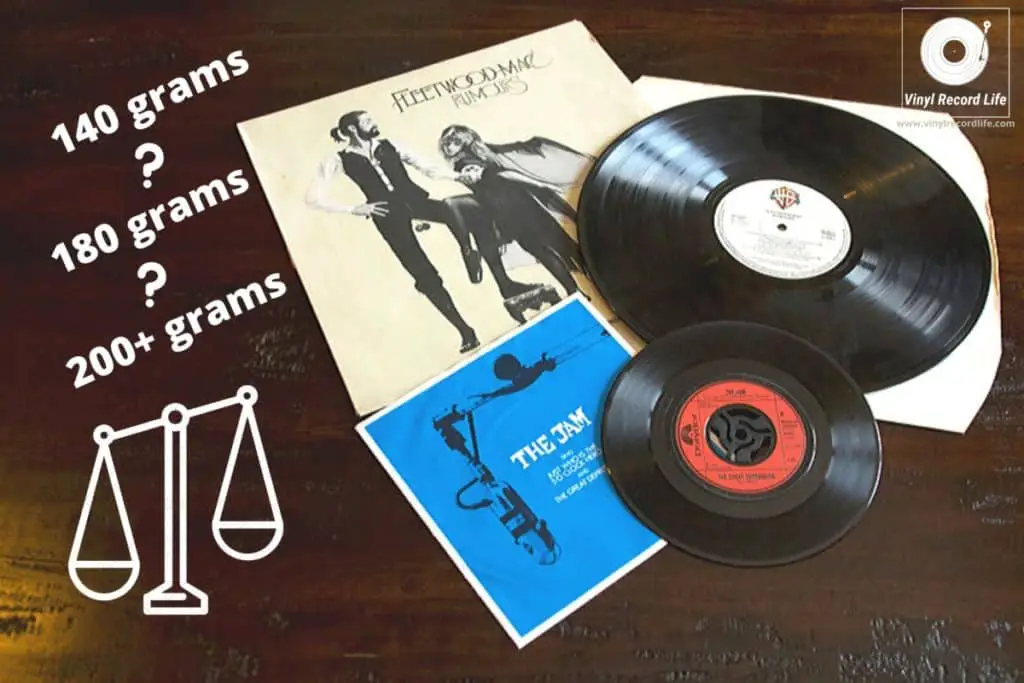
Ever held a vinyl record in your hands as you get ready to place it on the platter, and wondered: How much does this thing actually weigh?
I’ve done it with a few discs of varying sizes and weights, noting the different stated weights of certain records and wanting to know why the weight varies between discs that appear to be the same size. So I figured I’d look into it. Here’s what I found.
A 12” vinyl record will normally weigh between 120-150 grams, with many modern-day pressings weighing 180 grams. Some 12” discs can weigh as little as 90 grams and as much as 200 grams. A 7” vinyl record weighs between 40-50 grams.
The difference in weight between a 7” and 12” vinyl record is for obvious size reasons, but what’s the deal with a weight variation of anything from 120 right up to 180 or even 200 grams on a 12” record? What kind of impact can it have in terms of the sound of the record? And why do most modern-day 12” vinyl records now come in 180g and make a big deal of it on the record packaging?
All questions I used to ponder and which I’ve addressed here, so let’s get going.
The Progression Over Time in the Weight of Vinyl Records
Most of the records produced during the 20th century weighed between 120 and 140 grams. This was the standard normal range, although there were variations which saw the likes of RCA Records bring out their trademarked Dynaflex disc in 1969 that came in at around 80 grams, but which was discontinued by the end of the 1970s. Other records tipped the scales at as much as 200+ grams and were considered true audiophile grade pressings.
In recent years a trend towards 180 gram pressings has been notable, although the audible benefits of this are debatable and widely considered to be largely insignificant. We’ll talk more about the 180 gram development, as well as the question of whether weight impacts the quality of a record and the perceived advantages of heavier discs, later on.
Before we do, here’s a table that presents a selection of records from my own collection that I compiled, to help show the true variance and progression in the weight of vinyl records through time. I’ve tried to make the range as varied as possible in terms of record label and pressing year to give as representative a sample as possible.
| Artist | Album | Year of Pressing | Label | Weight |
| David Bowie | Aladdin Sane | 1973 | RCA | 125g |
| Fleetwood Mac | Rumours | 1977 | Warner Bros. | 120g |
| Marvin Gaye | Midnight Love | 1982 | CBS | 110g |
| Bloc Party | Bloc Party E.P. | 2004 | Dim Mak | 135g |
| Mansur Brown | Shiroi | 2019 | C&P Black Focus | 190g |
What Difference Does Weight Make?
It’s a logical question, because if there’s a variance in weight between records, it must be for a reason, right?
When looking into this, I found there were two main areas of focus on the question of the weight of a vinyl record. The first tended to lean towards asking what kind of impact weight had on the sound quality of the disc, and the other went more in the direction of what mechanical factors drove the variance in these weights. The two things were closely linked.
Heavier Records = Better Records?
In short, audiophiles tend to agree that (heavier) weight alone does not correlate to a better sound quality on the record. Superior sound quality is mainly down to the integrity of the master source, mastering process and the equipment that was involved. Whether a record is lighter or heavier does not make the difference to sound quality on its own. The technical standard by which grooves are modulated and cut on a record is exactly the same on all records, regardless of their weight.
A heavier record can change the vertical tracking angle of the turntable’s tonearm ever so slightly, but this difference is minimal and its impact on sound highly questionable. The impact could also be detrimental as much as beneficial to the sound, however small the difference.
A heavier record weight has been championed by some for other reasons. The heavier a record is, the thicker it is, and thicker records have been heralded as being more robust and durable. It’s also been suggested that a heavier record can have a more stabilizing effect on the stylus and cantilever suspension, which can help to provide extra protection from vibration thanks to the damping effect the extra grams can have, but the effects on sound reproduction are micro and therefore negligible.
Heavier Can Mean a Flatter Record Surface
Some record labels, such as Mobile Fidelity Sound Lab, developed technologies which incorporated pressing processes that produced a flatter record surface on records that weighed in around the 180g mark. In the case of MoFi, their tech was called Ultra High Quality Recording, or UHQR, and they pioneered it with JVC in the 1980s.
The flatness of the finished disc was due to the pressing die casts being designed in such a way as to minimize unevenness on the record’s surface, and while a flat surface does lead to benefits in the reading of the grooves, the overall relation with the finished weight of the vinyl record is dependent on too many other factors for the benefit to be credited to the heavier weight.
The Weight of a Record Is Just One of Many Factors
The truth is, there are so many factors that influence the quality of sound on a vinyl record that its weight is just one of many ingredients in a complex mix. There are records that weigh 130g and far out-perform 180g pressings for sound quality, and vice versa.
There are some myths associated with heavier vinyl too that should be dispelled, one being that the thicker vinyl on a heavier record means the grooves can run deeper. This is simply untrue.
Oftentimes, the real reason behind the differing weights of records that have the same diameter comes down to two main things; the resin mix used to make the record, and certain pressing preferences and processes of the factory making the disc.
We’ve discussed in another post the actual ingredients that go into making a vinyl record, and this has a massive influence on the final weight of the finished product.
We’ve mentioned just two labels in this post who developed their own specialized formats of record pressing (MoFi’s UHQR and RCA’s Dynaflex), and while these two trademarked formats may not be in production today, it’s still a valid example of the vastly different pressing methods and processes that labels employ, and which result in a wide range of thickness and, by default, weight.
What is 180-gram Vinyl and Is It Better?
So if weight doesn’t really make a difference to the sound quality of a record on its own, why has there been such a prevalence of 180g discs in the previous decade or so? Moreover, why is such a big deal made of it with the stickers placed on the covers of these newer pressings?
Back in the day, when 180g pressings were less common but still present, they were associated with a higher audiophile standard, partially because they were more costly to produce.
The sonic benefits of noise reduction from heavier records that we looked at earlier were also presented as benefits, and the labels that pressed the more expensive 180g records were widely viewed as taking far greater care in all steps of the process, from mastering to the quality of resin mix right through to the pressing standards in place.
Fast forward to the modern day, and while the same positive virtues about 180g records being stronger and more durable and therefore resisting warping a lot better remain true, the same rules also apply with regards to no discernible audible superiority in the recording that’s pressed onto the disc.
What has changed is that with vinyl’s 12-year run of year-on-year sales growth (as per RIAA stats), it has become a marketing technique to use the 180-gram label as a means of stating a disc’s superior quality, irrespective of whether the material used in the construction of the record or the mastering process were themselves superior.
With this weight of pressing becoming the standard, the perceived added value by a consumer spending anything from $25-$50 on a record at a retailer such as Barnes & Noble means that the slightly higher production cost of minting a 180g disc becomes a worthwhile one for the label.
